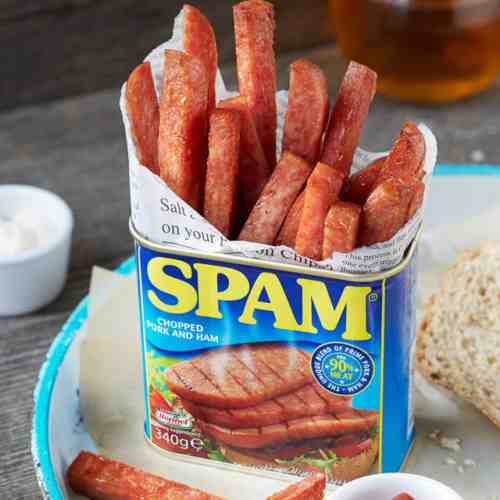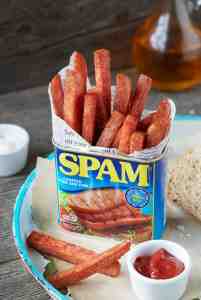Does Tulip taste like Spam?

It tastes like SPAM. Exactly like SPAM. Exactly. It’s a little less salty than classic SPAM, but not too much. This may interest you : What does Spam stand for?.
Which is better spam or tulip? A blind SPAM taste test, with results that make SPAM maintain its dominance by the judges both in terms of knowing its taste and, more importantly, its brand. Despite this, Tulip proved its worth and stood against SPAM in almost all respects, even getting one judge.
Is Tulip same as spam?
But all over the world, canned meat is also known by a different name: Tulip Pork Luncheon Meat. On the same subject : Is luncheon loaf the same as spam?. “It’s very much the same as spam,” explained Stig Pedersen, plant manager at the Tulip factory in Vejle, Denmark, where more than 130 million cans of pork are produced each year.
Is Tulip a Spam?
Tulip Food Company, a subsidiary of Danish Crown, opened its factory in Vejle in 1988. Its biggest product is Tulip Pork Luncheon, the Danish equivalent of Spam. The cans are sold in over 100 countries, including England, Germany, Japan and the USA.
What is Jamonilla made of?
Ingredients: Ham, pork, water, starch, salt, sugar, sodium phosphate, sodium caseinate, flavors, sodium ascorbate, sodium nitrite.
What is Tulip ham?
€ 439.00. Made and packed in Denmark. Foods rich in protein. To see also : What is the difference between junk and spam?. Available in sausage, cocktail sausage, dinner meat, picnic ham.
Where is Tulip luncheon meat from?
Tulip Pork Luncheon Meat has a balanced meaty flavor and is perfect for rice and pasta dishes. It is made of 100% Danish pork and 100% imported from Denmark.
Who makes Tulip luncheon meat?
Tulip Food Company, a subsidiary of Danish Crown, opened its factory in Vejle in 1988. Its biggest product is Tulip Pork Luncheon, the Danish equivalent of Spam. The cans are sold in over 100 countries, including England, Germany, Japan and the USA.
Why Do Hawaiians call spam tulip?
Spam has been the undisputed king of canned meat in Hawaii ever since the curious, jelly-like pink pork brick was introduced to the islands during World War II. But a Danish imitator named Tulip is trying to get spam out of the throne. In Hawaii, spam is more than a four-letter word for unsolicited email.
What Hawaiians call Spam?
His perception there is completely different than on the continent. Hawaiians sometimes call it “Portagee Steak”. A local dish in Hawaii is Spam musubi, in which cooked Spam is placed on top of rice and wrapped in a belt of nori, a form of onigiri.
Is Spam a Hawaii thing?
There is probably only one food in Hawaii that is more ingrained in the island’s culture than pineapple – and that food is spam. This quintessential canned ham produced in Minnesota was introduced to the islands in the 1940s and has become an wildly popular staple food on the islands.
Does Aldi sell Spam?

While real spam has a lot of delicious flavors, there is nothing you will like about Brookdale Pork Luncheon Meat. Unless you plan on buying it to feed your worst enemy, there’s no reason for this canned garbage to end up in your Aldi cart.
Where does Aldi’s food come from? Most of the Aldi beef you find in your local stores comes from local or regional cattle farms. Some, notably organic grass-fed ground beef, are partially imported from South America, but not from China.
Does Aldi use BPA free cans?
Bisphenol-A (BPA) Reduce BPA in our exclusive ALDI branded products where possible and make great progress. Mark all BPA-free products with the following symbols: BPA-free packaging and BPA-free lining.
What canned foods do not contain BPA?
BPA-free cans
- American Tuna: All canned tuna.
- Amy: All products. …
- Baby formulas and foods: Beech Walnut, Enfamil, Gerber, Baby’s Only, Pedialyte, PediaSure and Similac are now available in BPA-free packaging. …
- Beach Cliff: All canned fish including fish steaks and sardines.
Where does ALDI get their canned food?
While Aldi’s food is mostly sourced outside of China, the supermarket chain also has a solid line of household items, pet supplies, clothing, etc. that they sell and list weekly as Aldi Finds. If you look at the packaging of your Aldi Finds you will see that some are indeed from China.
Who makes happy harvest canned?
Happy Harvest Beans Another of Aldi’s own brands, Happy Harvest Beans are just as good as the more popular one with the green guy on the label.
Where does Aldi canned food come from?
While Aldi’s food is mostly sourced outside of China, the supermarket chain also has a solid line of household items, pet supplies, clothing, etc. that they sell and list weekly as Aldi Finds. If you look at the packaging of your Aldi Finds you will see that some are indeed from China.
Who owns Happy Harvest?
HAPPY HARVEST A trademark of ALDI INC. – Registration number 1055229 – Serial number 73087075 :: Justia trademarks.
Who makes Brookdale luncheon meat?
Aldi’s spam is called “Brookdale Luncheon Meat.” I ate it and it’s good. However, while moving in last week, my wife discovered a very disturbing problem. Of the 10 cans of this we had in our locker, 8 were swollen.
What is the difference between SPAM and treet?
“Treet is a canned meat product similar to SPAM that is marketed under the Armor Star brand by Dial Group in the US. Treet is made from chicken and pork. SPAM is made from ham and pork. Treet is often cheaper than SPAM. “
Where is Prem luncheon meat from?
PREM is a brand of Zwanenberg Food Group and is manufactured in the United States. In Canada, it is a trademark of Maple Leaf Foods Inc./Les Aliments Maple Leaf Inc. and it is luncheon meat produced in Canada marketed under the Swift brand as Swift’s Prem. PREM is similar to spam and was sent to England during World War II.
Does Spam need to be refrigerated?

Cooling down leftover spam. Cooling is the second method of storing residual spam. If done correctly, your Spam can keep the best quality for about 4 days to a week in the refrigerator. There is some freedom here as the storage conditions will have a big impact on its viability.
How long can you skip spam? After months of negotiation, the Department of Health recently announced a revised draft rule to allow local favorites such as Spam mustubi to be stored at room temperature for up to four hours. Then the food should be discarded.
How do you know if Spam is bad?
Eyesight is usually the best way to tell if your spam and other canned goods have gone bad. If the top of the can is rounded and dome shaped rather than flat across, the meat has most likely spoiled and the can should be discarded.
How long is spam good in the fridge?
As a general rule, use the product within three to five days and store it in the refrigerator after opening. So 3-5 days is Hormel’s official response to “chilled meat products”. It’s a bit disappointing that they don’t have a proper spam response.
What happens if you eat expired spam?
Can you eat expired SPAM? As long as the can is undamaged, you can safely eat SPAM long after the use-by date. However, as time goes on, it really starts to lose its quality. Ideally, you should consume SPAM no later than 2 or 3 years after its use-by date.
Does opened Spam need to be refrigerated?
As a general rule, use the product within three to five days and store it in the refrigerator after opening. So 3-5 days is Hormel’s official response to “chilled meat products”. It’s a bit disappointing that they don’t have a proper spam response.
Do you need to refrigerate Spam after opening?
However, if you plan to consume leftovers during the week, know that this may not be the best way. This is because the spam defrosting process will be a tedious and time consuming process. If you want to eat your spam soon, try chilling it.
How Long Can Spam sit out?
“Nobody is endangered by it.” The state agreed to negotiate. After months of negotiation, the Department of Health recently announced a revised draft rule to allow local favorites such as Spam mustubi to be stored at room temperature for up to four hours. Then the food should be discarded.
Does unopened Spam need to be refrigerated?
It does not require refrigeration, and spam is “unlimited” in storage, according to the Hormel website. Hormel also says spam will be safe to eat for much longer than the Enjoy By date, although its taste may diminish over time.
How long is Spam good for unopened?
| (Unopened) | Pantry |
|---|---|
| Date of the previous printout | |
| Spam continues | 2-5 years |
| Canned Chicken goes on | 2-5 years |
| Canned tuna is enough for | 2-5 years |
How do you store Spam meat?
To maximize the shelf life of your canned luncheon meat, store it in the refrigerator in a covered glass or plastic container. How long does open luncheon meat remain in the refrigerator? Luncheon meat that has been continuously chilled can be stored for about 3 to 4 days.
Is ham healthier than SPAM?

So yes, there is a difference between ham and spam. Spam contains more calories, more fat, and less protein. But the difference isn’t as big as expected, especially considering you can get 340g of spam for $ 3.48 pre-tax, and yesterday I paid the same amount for 100g of Black Forest ham at Choices.
Are canned ham and spam the same? One of the best known forms is SPAM®, a product that is technically not a ham because it combines several different pieces of meat. Canned hams were popular during World War II. Most often, canned ham is mixed with other ingredients so that they do not go to waste.
What is the difference between Spam and ham?
A “ham” is an email that is not spam. In other words, “no spam” or “good mail”. It should be considered a shorter, more snappy synonym for “spam free”. Its use is especially common among anti-spam software developers, and is not widely known elsewhere; in general, it is probably better to use the term “spam free”.
Is Spam and ham the same?
It might be a nice surprise to know that SPAM is not a secretive meat packed with preservatives to think about. In fact, SPAM only contains six ingredients! And the brand’s website lists them all. These are: pork with ham (counts as one), salt, water, potato starch, sugar, sodium nitrite.
Is canned ham Spam?
Spam is a cooked, canned meat product made from minced pork and processed ham. The meat mixture is combined with preservatives and flavorings such as sugar, salt, potato starch, and sodium nitrite, and then canned, sealed, and vacuum-packed.
Is canned ham healthy?
Canned Ham Ham is a lean protein source that provides essential vitamins, minerals and amino acids. It is especially rich in selenium. Due to its rich nutritional profile, it is said to aid weight loss, help maintain muscle mass, and reduce certain types of inflammation (8).
Is canned ham real meat?
In short, canned ham is pork, cured in salt and water. The meat is then pressed or formed into vacuum cans prior to steaming. What is this? Canned ham regularly contains meat and other inexpensive ingredients, making it a more affordable product while maintaining the flavor of the ham.
Is Hormel canned ham processed?
According to the USDA, these hams are still fully cooked and therefore safe to eat, but are not processed long enough to remain stable during storage, so they must stay cold to avoid spoilage.
Is there a healthy Spam?
Heavy in taste, light in others. This variety offers a delicious SPAM® Classic with 33% less calories, 50% less fat and 25% less sodium, meaning you can enjoy your favorite flavor more often. This is the perfect SPAM® variety for the bathing season.
Is there a healthy version of Spam?
It is not nutritious and should only be used as a delicacy. Fortunately, there are plenty of alternatives to spam if you are looking for a lower fat substitute. These include pork roll, potted meat, scrap, jambon, and tofu – all of which can offer the same high protein content without any unhealthy ingredients.
Is there an organic version of Spam?
The spammer is the last to join the healthy eating movement. Hormel Foods (HRL), a company that makes the famous canned meat, announced that it will buy Applegate’s organic meat brand for approximately $ 775 million.
Is there a healthy Spam?

Heavy in taste, light in others. This variety offers a delicious SPAM® Classic with 33% less calories, 50% less fat and 25% less sodium, meaning you can enjoy your favorite flavor more often. This is the perfect SPAM® variety for the bathing season.
Is there an organic version of spam? The spammer is the last to join the healthy eating movement. Hormel Foods (HRL), a company that makes the famous canned meat, announced that it will buy Applegate’s organic meat brand for approximately $ 775 million.
What is a good substitute for Spam?
The 6 best healthy alternatives to spam
- TREE- Similar to SPAM.
- CORNED BEEF – the perfect substitute for spam.
- HAM- Easy alternative to spam.
- Try PREM instead of spam.
- Replace Spam with MEAT FOOD IN POT.
- BOLOŃSKA SAUSAGE – a substitute for spam.
What meat is similar to Spam?
Treet (Armor Star Treet) is a canned meat product similar to spam first introduced in 1939 by Armor and Company in the United States. Sold as a ‘spiced luncheon loaf’, it is made of chicken and pork and has a finer texture than Spam, more akin to a Bolognese or Viennese sausage.
Is Spam similar to ham?
Like ham, spam also consists of separate pieces of pork. Like ham, these are often undesirable pieces that would otherwise not find their way to consumers. So the last remaining piece of the comparison that can prove that ham is better than spam is its nutritional value.
Is there a healthy version of Spam?
It is not nutritious and should only be used as a delicacy. Fortunately, there are plenty of alternatives to spam if you are looking for a lower fat substitute. These include pork roll, potted meat, scrap, jambon, and tofu – all of which can offer the same high protein content without any unhealthy ingredients.
What meat is actually in Spam?
What distinguishes Spam from other products made of chopped meats that are cooked and pressed together (we think of scraps): Spam consists of pork shoulder and pork ham, with no other pork leftovers. The pork shoulder is today considered a high-quality piece of pork, although in 1937 it was not.
What is Spam actually made of?
It might be a nice surprise to know that SPAM is not a secretive meat packed with preservatives to think about. In fact, SPAM only contains six ingredients! And the brand’s website lists them all. These are: pork with ham (counts as one), salt, water, potato starch, sugar, sodium nitrite.
Is there a healthy version of Spam?
It is not nutritious and should only be used as a delicacy. Fortunately, there are plenty of alternatives to spam if you are looking for a lower fat substitute. These include pork roll, potted meat, scrap, jambon, and tofu – all of which can offer the same high protein content without any unhealthy ingredients.
What is spam really made of? It might be a nice surprise to know that SPAM is not a secretive meat packed with preservatives to think about. In fact, SPAM only contains six ingredients! And the brand’s website lists them all. These are: pork with ham (counts as one), salt, water, potato starch, sugar, sodium nitrite.
What meat is actually in Spam?
What distinguishes Spam from other products made of chopped meats that are cooked and pressed together (we think of scraps): Spam consists of pork shoulder and pork ham, with no other pork leftovers. The pork shoulder is today considered a high-quality piece of pork, although in 1937 it was not.
What meat parts are in spam?
Spam is a cooked, canned meat product made from minced pork and processed ham. The meat mixture is combined with preservatives and flavorings such as sugar, salt, potato starch, and sodium nitrite, and then canned, sealed, and vacuum-packed.
What part of spam is pig?
According to spam.com, pork comes from the pork shoulder. Salt, water, and sugar are all familiar to us all, so it leaves behind potato starch and sodium nitrite to be explained. The food industry uses potato starch as a thickener, binder or gelling agent.
Sources :
